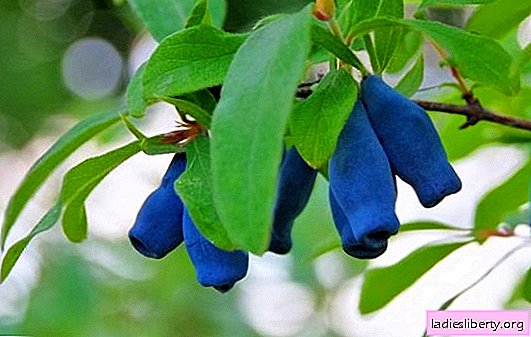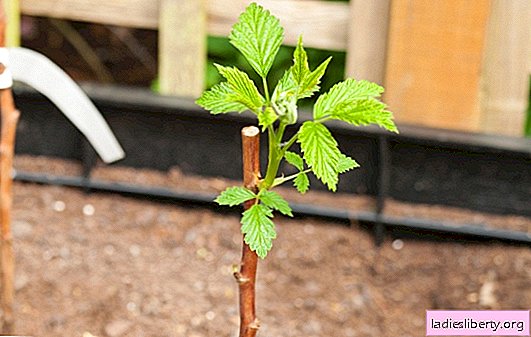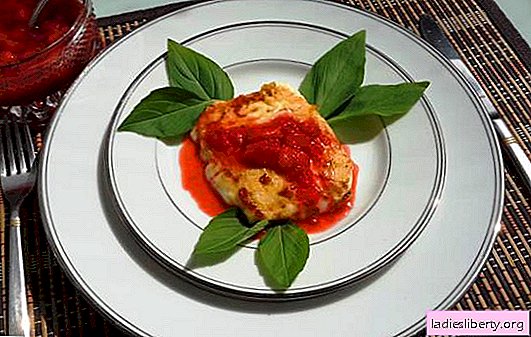
For many gardeners, in order to save space on their personal plot when choosing plants for planting, it is important to get a “2 in 1” result: decorate the plot and get the benefit.
Such a decision would be to plant edible honeysuckle, caring for which would not cause much trouble.
This shrub will not only decorate the site, but will also delight with its delicious and healthy berries, which in terms of ripening overtake other berry crops by 1-2 weeks.
In addition, honeysuckle is unpretentious to growing conditions, frost-resistant (its wood, roots and buds withstand frosts down to -40 ° C).
Features of planting edible honeysuckle
Although this culture is considered an unpretentious shade-tolerant plant, still for its abundant fruiting better planted in bright areas.
From soils, honeysuckle prefers well-fertilized with organic fertilizers. loams with a neutral or slightly acidic reaction.
On acidic soils, leaves turn pale, yield decreases. The proximity of groundwater contributes to the decay of the roots of this shrub. Such areas must be drained before planting.
Honeysuckle flowers bisexual but self-infertileTherefore, they need cross-pollination by insects (bees, wasps, bumblebees). To get the maximum yield, it is important to plant different-grade bushes in groups of 3-4 each. When purchasing seedlings, it is worthwhile to carefully study the description of varietal characters in order to choose varieties suitable for pollination of each other.

The period of planting of honeysuckle depends on the characteristics of its vegetative cycle. In the spring, it wakes up early (the buds begin to bloom in the last decade of March - early April). During this period, it cannot be disturbed, otherwise the plant will weaken and the harvest may not be expected this year. If there is still an urgent need to plant or transplant the honeysuckle in the spring, then this can only be done by transshipment, without destroying the earthen lump.
By the end of July, vegetation stops. Therefore, the time from August to mid-November is most favorable for honeysuckle planting.
Bushes are planted 1.5-2 m apart, since by 6-10 years of life they grow to 1-1.5 m in diameter and 1-1.8 m in height. If you greed and plant the plants denser, then in the future, with inaccurate harvesting or care, the branches of honeysuckle will easily break. When landing in several rows, the distance between them is 2-2.5 m.
Landing the holes are made in the size of 0.4x0.4x0.4 m. Organic matter (rotted compost or manure), granular superphosphate (40 g), potassium salt (30 g) and 200 g of wood ash (the amount of fertilizer per each bush) are added to the earth removed from the pits. A mound of such height is poured from the obtained soil mixture in the hole so that when a seedling is placed on it, its root neck is 3-5 cm below the level of the pit. Then the honeysuckle roots are straightened, covered with the remaining soil and watered. The trunk circle is mulched to reduce the rate of evaporation of moisture from the soil.
Important! Edible honeysuckle when planting does not need to be pruned like other berry bushes. Otherwise, the development of the plant and its bearing will slow down.
Trimming is only a 16-20 year old adult bush for its rejuvenation.
In this case, gradually (every year) skeletal branches that ceased to bear fruit are removed from it.

Rejuvenation of the old honeysuckle bush: 1- old neglected bush, 2- bush after anti-aging pruning
Reproduction of edible honeysuckle (photo)
Honeysuckle can be propagated in the following ways.
The seed method is used mainly in breeding to obtain new varieties. However, if you wish, you can try to grow honeysuckle from seeds. To do this, the collected seeds are sown in boxes to a depth of 1 mm and placed in a greenhouse or left in room conditions (in this case they are covered with glass to create increased humidity). After 3 weeks, seedlings begin to appear. After growing a pair of real leaves in seedlings, they are dived into separate containers. In September, young plantlets are planted on a bed according to a 5x5cm pattern. After a year, they are planted according to the scheme of 20x20 cm. At 5-6 years of vegetation, they will begin to bear fruit, however, the taste qualities of the berries can differ greatly from those obtained on the parent bushes.
It is even easier to sow seeds in the fall and leave the boxes in the garden under the snow for natural stratification (exposure to cold). In the spring, to speed up the emergence of seedlings, the boxes are brought into the greenhouse. The process then proceeds as described above.
Honeysuckle can also be propagated by dividing the bush. This procedure is carried out only on plants that have reached 8-15 years of age. The honeysuckle wood is very strong, therefore, when dividing it, an ax and a hacksaw will be required. Each delenka should have 2-3 skeletal branches and a root more than 20 cm long. After division, landing is carried out immediately in the prepared wells.
Propagation of honeysuckle by edible green, combined and lignified cuttings is the most common way. Harvesting cuttings done in the last decade of March before the dissolution of the kidneys. Strong annual shoots are cut into pieces of 15-20 cm long and planted on a bed in a greenhouse. The cuttings are deepened to 2 upper kidneys. After 30-40 days, rooting occurs.
Combined cuttings are harvested immediately after flowering. For cutting, choose last year's branches with lateral growths of the current year. Cutting is carried out with a “heel”, i.e. so that at the base of the young shoot there is a piece of the main branch.

Combined handle with a heel
Before planting, for better rooting, the cuttings are immersed for a day in a solution of heteroauxin or Kornevin.
After that, they are stuck on a prepared bed to a depth of 3-5 cm and covered with a film. Seedlings are watered with such a frequency that the soil is constantly moist. After 15-20 days, roots form in the seedlings and growth begins. They are transplanted to the main place next fall.
Green cuttings are harvested during the period of staining berries. This year's shoots are cut into pieces and root them in the same way as combined cuttings in conditions of high humidity of air and soil (under a film or in a greenhouse). The next year (in the fall) they are transplanted to a permanent place.

Green honeysuckle prepared for planting
Fruits seedlings grown from cuttings begin for 3-4 years of vegetation.
Edible honeysuckle is easily propagated by layering. In June, the soil under the bush is loosened, the lower annual shoots are bent to the ground and fixed with garden hairpins in several places. These sites are sprinkled with earth and regularly watered throughout the summer season. The next spring layering is separated by secateurs from the parent plant and transplanted into the prepared bed.

Honeysuckle propagation by layering
Edible Honeysuckle Care
Honeysuckle care is pretty simple. The first three years of seedlings' life, care consists of watering, loosening near-stem circles, removing weeds and controlling pests and diseases.
Honeysuckle does not need annual pruning, as mentioned earlier.
After planting, honeysuckle top dressing is carried out from the third year of its vegetation. When the snow begins to melt, in the spring, nitrogen fertilizers (for example, ammonium nitrate) are scattered under the bushes, 1 tablespoon per plant or watered with a solution of urea (25-30 g per bucket of water). After harvesting, a second top dressing with nitroammophos (25 g per 10 liters of water) or mullein infusion (1:10) is carried out. At the end of summer, 100 g of wood ash and 30-40 g of double superphosphate per 1 m2 are added.
Honeysuckle is watered taking into account climatic conditions. If the summer is not hot, then the amount of watering per season is 3-4 times. Each bush will require 10 liters of water at a time. With a lack of moisture, the quality of the berries will decrease - they will become bitterness. After watering or rains, the soil under the honeysuckle is loosened. To preserve moisture, it is better to mulch it.
There is no need to cover edible honeysuckle for the winter. This shrub tolerates low temperatures well.











